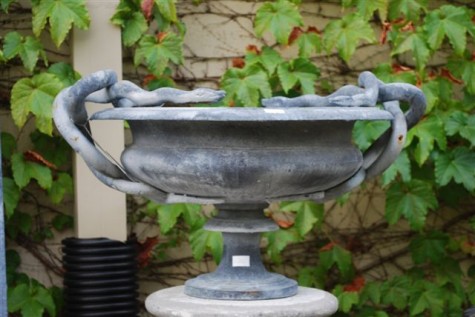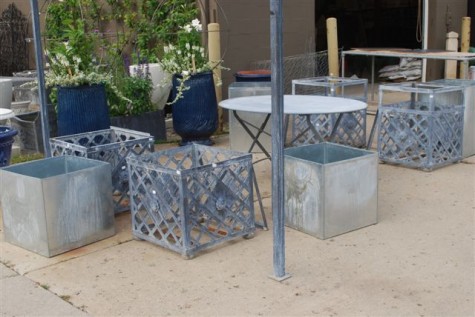
The manufacture of garden ornament, vases and sculpture in many ways was a revolution of sorts. Most garden ornaments of antiquity were created at great expense and time, as in hand carved, or sculpted, one piece at a time. This meant great garden ornament was restricted to just a few patrons of the garden arts. As lead is quite malleable, and melts readily, it can be cast. This meant ornament could be cast in multiples, and a favorite stone ornament could be reproduced at much less expense than hand-carved stone. Imaginative manufacturing techniques made lead ornament of all kinds readily available. This drop dead gorgeous stone and lead garden ornament pictured above was designed by, and executed under the direction of Beatrix Farrand, and installed at one of her best known landscape projects, Dunbarton Oaks, in Washington DC, in the 1920’s.

The Bulbeck foundry in England produces some of the finest lead garden sculpture, ornament and pots available anywhere in the world. The giant egg cup with acorn, oak, grape and rose motifs is astonishingly beautiful. It is a modern interpretation of an old lead planter from the National Trust gardens at Anglesey Abby. The Bulbeck square planter, with its delicate Florentine scrollwork decoration, clearly illustrates the degree of detail possible with lead casting. Bulbeck lead is what I call the midnight blue four-door Ferrari coupe of garden ornament. Lead panels out of the mold are rough beyond belief; the art here is in the hammering and finishing which produces the fine ornament you see here. The people who make these pots are artists; they literally sculpt these pots from a rough approximation of the finished piece. Of more modest provenance and finish , the small plain lead egg cup pictured here is the work of the noted Canadian lead manufacturer, Richard Davies. His lead has some steel content; the difference in surface and color between the two manufacturers is evident. Any or all of these pots would make much of a planting.
 This lead running fox is the work of HCrowther Ltd, which has been manufacturing lead garden ornament in London since 1908. Their sculpture is particularly fine. This very appealing sculpture is as at home in a stone trough as it would be in the lawn. My personal choice-set in a bed of European ginger.
This lead running fox is the work of HCrowther Ltd, which has been manufacturing lead garden ornament in London since 1908. Their sculpture is particularly fine. This very appealing sculpture is as at home in a stone trough as it would be in the lawn. My personal choice-set in a bed of European ginger.

This Crowther fountain is equally as striking. An entire garden could be designed around it. This fountain design has been in production many many years. Lead, and classic lead design, weathers and ages in a garden so gracefully.
 This very old lead cistern carries the evidence of its age. The dealer in England from whom this piece was purchased thought it likely was at least two hundred years old. Wave the history card in my face, and I am done in.
This very old lead cistern carries the evidence of its age. The dealer in England from whom this piece was purchased thought it likely was at least two hundred years old. Wave the history card in my face, and I am done in.

Lead garden ornament has become incredibly expensive. The lead itself has doubled in price in a very short time, and the process is dirty, dangerous, and laborious. The steel furniture, spheres, and boxes pictured above have a finish very reminiscent of lead. This finish has the added advantage of protecting the steel from rust. Steel is strong enough for furniture. Boxes and pots made of steel do not collapse from their own weight, as lead is prone to do. But best of all, this beautiful look can be had for much less than lead.

This old French iron snake urn has a new life, and a vastly different feeling than the rusty original. Rarely would I touch the surface of an antique piece, but this piece was rusted beyond charming. Removing the rust brought the snakes, and the beautiful shape of the urn, back to life.
These acid washed steel boxes and galvanized planters are awaiting painted liners in the color of the client’s choice. Steel combines well with other materials.

The galvanized sheet metal liner of this steel box has also been acid washed. We can manufacture this large box very reasonably. I like good quality garden ornaments being available to lots of people. Manufacturing in multiples, with less expensive materials, makes this possible.

Whether you choose lead or acid treated steel, it is indeed a very handsome look.
the large leafed plant at the bottom of your planter looks like a plectranthus….but which one????
would you please discuss the (if) there are any dangers in using lead sculpture in the home garden settings. My understanding is lead is a toxic substance and i wonder if putting these pieces in the garden or part of a fountain is OK /
Thanks
Eliot, Lead is damaging to the brains of developing children-and dust from lead paint is harmful. It is not harmful unless you breathe it in its dust, or ingest it. There are many plants that are toxic-but only if you eat them. Lead in the garden or in a fountain is fine. Deborah